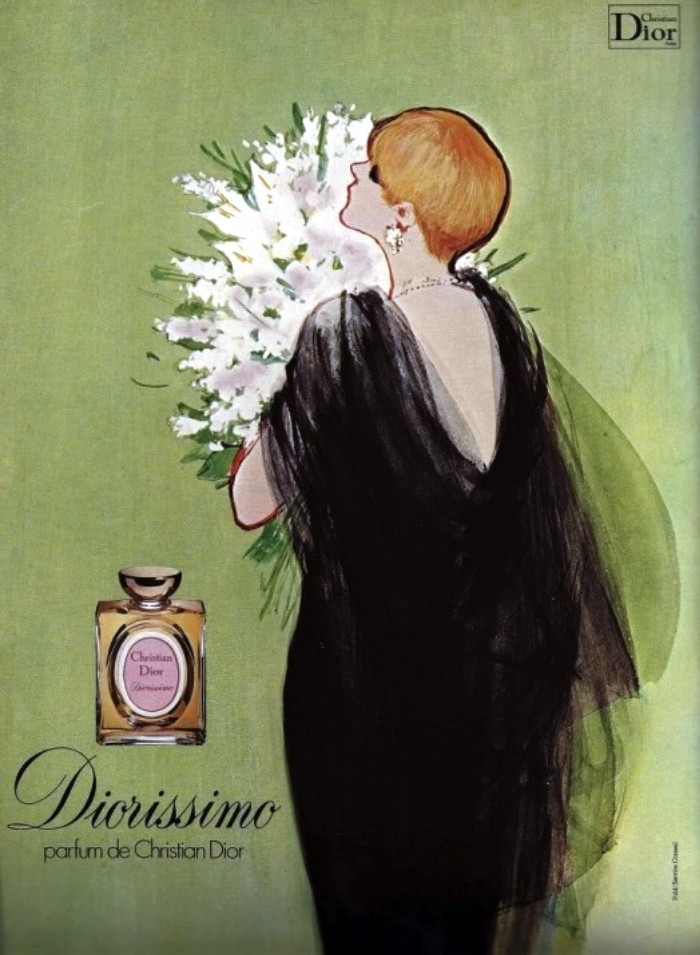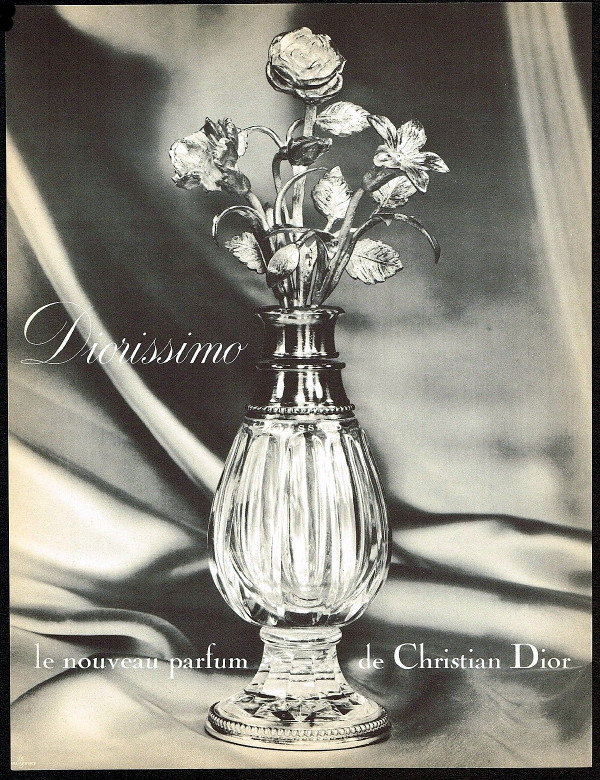Christian Dior Diorissimo (1956 / 2009) ≈ Strange Reformulation, or The Spirit of Jasmine Takes Over That of Muguet: Transition Phase, Latest Version {Perfume Review}

We're publishing for the first time the article below which was written in 2009. We think that as Hermès is launching a new muguet composition by Jean-Claude Ellena this spring, which pays homage to the classic Diorissimo, now was the time to link the present with the past, anew, so as to gain better insights into the history of this recurring human endeavor, the muguet perfume.
The muguet or lily of the valley flower is feted each year in France on May the 1st since the time of king Charles IX. For this reason I had been anticipating that I would be one day doing a review of Diorissimo by Dior, the ultimate muguet composition.
In the annals of perfume history it stands as a famous lily-of-the-valley "soliflore" - it really goes beyond that terminological oversimplification - created by perfumer Edmond Roudnitska, in part to pay homage to Christian Dior's fetish bloom. The French fashion designer considered it his lucky-charm and would sew it everywhere, onto dresses, hats, shoes, what not - and even made his models carry hidden sprigs of lily-of-the-valley for luck during his runway shows...
We had heard that Dior's coffin the day of his funerals was covered with the delicate little white bells when the time came to bid adieu to the couturier. So I looked for a picture proving that story and found one in an old magazine, which confirmed this was no legend but fact.
In retrospect, the image of Dior's beloved muguet being mournfully carried away on a coffin draped in black is unfortunately only too apt to translate the idea of the silent fading-away of Diorissimo - the version that can still be purchased today in stores rather than in antique shops.
The Diorissimo that can be experienced today, in 2009, has undergone quite a strange reformulation process. It is unlike Guerlain Mitsouko not just a pallid copy of itself, which attempts to remain faithful but fails ultimately due to technical reasons - the 2009 Mitsouko Fleur de Lotus version paradoxically is a bit closer to the original, do not let the green coding of the bottle disorient you. It is more like a profound disregard for what the scent aimed to be: a purely focused lily-of-the-valley perfume that in fact expressed spring, seemed to peal with a crystalline laughter, could evoke refreshing fountains, and offered a clarity of structure that was like a classic French garden. The scent was expressive of spring to the power ten, especially probably for the French who have been socialized into associating the smell of muguet with a special period of time in the springtime.
All of the essential former traits have vanished into thin air. What remains is a Diorissimo that is not completely interred, but certainly in the silent throes of agony. All of this of course is said from the point of view of an old-time wearer. From the point of view of the perfumers in charge of the reformulation, well, they have to make the best of it.
In 2009, we had an exchange with Dior Parfums regarding the reformulation of Diorissimo, who then asked their perfumery lab who answered that,
"As soon as the IFRA comes out with a new amendment (which is once a year) our regulations department checks that our formulas follow all restrictions and/or prohibitions regarding ingredients or raw materials; if an inconsistency is detected, we rework our fomulas in order to be within the new regulations.
With regards to Diorissimo, the most recent change in order to follow IFRA recommendations took place in 2007"
So Diorissimo, as well as other classics, have to be constantly reformulated. This is the olfactory reality we live in. When asking who was in charge of the reformulation, Dior answered,
"All of our fragrance adaptations (since 2005) were done under Francois Demachy, Dior's Perfumer-Creator."
This is all well and good. The most incomprehensible part for me is why the reformulation made the choice of smothering the characteritic lily-of-the-valley accord with a very sunny, furry and fruity jasmine?
Next, why did the reformulators decide to turn a perfume that was limpid and fresh into a warm, opulent floral, again, dominated by jasmine? Now it smells more like summer and sultriness than the fresh awakening of nature.
Even a superficial knowledge of the personality of Roudnitska immediately makes you realize that, unless we are mistaken and he was more or a realist or cynic than I have been able to appraise, he would not want to see his name attached to the new rendition. The perfume stands like a betrayal of his aesthetics, smelling even contrarian in spirit to the original perfume. How strange.
It is a pity that France, which is a country so attached to its artistic, artisan and intellectual patrimony, has no official state system to grade, evaluate and decide which perfumes to preserve as art monuments; it would not be far fetched to think of certain perfumes as "monuments historiques". For a country that so values its literary heritage, think of the loss of not being able to connect with the spirit of Fougère Royale by Houbigant, the favorite perfume of Guy de Maupassant. We could read his short stories and novels knowing that this emotion in liquid form was the olfactory background to his thoughts. Or to not be able to smell one of the favorite perfumes of Colette, a jasmine by Gabilla. There should be a museum that links perfumes to the zeitgeist, the personalities, the ideas and cultural trends that made those possible, that were nurtured by the art of fragrance. Alas, we are far from such an institutional protection.
The Osmothèque is doing what it can - and this is wonderful. But in France, to receive the sanctification of the state is a supplementary step in the direction of assured transmission of the patrimony. Left to private interests and people's good will, the legendary perfumes of the past become more and more the stuff of tales and myths and less and less a part of our collective lives. And we have to recognize that all-too-real fact: perfumes are mortal, like us. Some scents may have helped us remember the past, our cherished ones. But like human beings, they will slowly fade away and it seems irremedially so.

The Problem of Curatorial Responsibility
There is still a tinge of Diorissimo in the present-day scent, but as if trampled upon. The muguet in it, we feel, has turned into a doormat. One might then legitimately ask the question: wouldn't it have been better to just kill off the perfume, but not the memory (preserved in a museum of perfumes with integrity), and then move on?
Impersonating a perfume by using its name, its historical aura, its cultural heritage is just recognizing the fact that perfume does not matter and that it is not an intellectual form. Imagine a Mona Lisa poorly restored with a new twisted smirk - and new colors. You could do that only as a new, renewed artistic statement. But you could not attribute it anymore to Da Vinci. But this is what happened with Diorissimo because there is simply not enough official respect for the work of perfumers. Granted, not every perfumer's work merits protection for originality, but like all museums, a state museum of perfumes would make curatorial choices.
The new Diorissimo has a certain appeal at first because it unfolds as a lush solar jasmine lightened up by lily-of-the-valley. Lovers of opulent florals with a near-tropical richness to them will appreciate this opening. But the ones who are looking for the old Diorissimo will feel it has been callously reformulated.
The new Diorissimo is very linear, simplified and decreases in power as the scent dries down. The lily-of-the-valley is more perceptible once the jasmine recedes, but at this point it looks like a faded handwriting in pale yellowed ink on an old letter. If you want to smell the crumbs of Diorissimo, you can still manage to do so here and there. But the perfume has been wrecked. And, unfortunately again, it is not the only one. Ma Griffe by Carven has turned into a bad joke.
Transition phase (pink packaging): it starts much more jasminey, indolic and solar than the old Diorissimo but moves into the old sparkling Diorissimo persona with its fruity citrusy roundness, gaity, sprinkling of pepper and freshly cut green stems. Later: creamy and peppery with a mouth-watering quality (the custardy noted from ylang?) just right, never heavy, lifted up by citruses. The blow-back smells of island ylang, a solar tropical touch that I do not recall from my memories of Diorissimo. There is a bewitching saltiness and perfumed hot-sand accord - it is so 50s! So clean! It makes you think of Jacques Tati, the clean Christian Dior dresses that were inspired by the little girls' dresses of les petites filles modèles of Comtesse de Ségur, of the couturier's own avowal.
The old version has much more lift, and is delectably peppery. It has a longer drydown which is both buttery and mossy. It is gifted with a happy personality. It laughs. Its voice is crystalline. It moves. It is no more, alas.
Upon smelling the new Muguet Porcelaine by Hermès in 2016 composed by perfumer Jean-Claude Ellena we can say in preamble that it smells delightful. More importantly still, the spirit of Diorissimo is back. It is a homage of Ellena to his mentor, Edmond Roudnitska, and to the original spirit of Diorissimo.
Stay tuned for our review of Muguet Porcelaine.










Last time I tried Diorissimo, it smelled like paint thinner. I wish I'd got jasmine.
Haven't smelled it recently. This was my olfactory shock - not in a good way - back in 2009